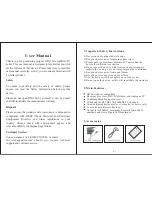
3.5 Antenna location requirements
The antenna can be used to improve the reception
of your MFD’s built-in GNSS (GPS / GLONASS)
receiver. Do NOT connect any other antenna to the
MFD’s GA150 connector.
The antenna can be mounted either on a flat
horizontal surface or on a suitable pole.
• If you intend to surface mount the antenna, ensure
you have access to the underside of the mounting
surface.
• If you intend to pole-mount the antenna, the pole
needs to have a 1 inch 14 TPI thread.
Important:
The antenna must be mounted in a
location that provides a good direct line of site to
the entire sky, around the horizon.
Ensure that the selected mounting location is:
• Open and clear of any obstructions (such as
masts, search lights, or other structures) that could
block line-of-sight to the sky.
• As low as possible, to keep the antenna as stable
as possible. The more stable the antenna, the
more effectively it will track satellites and provide
stable data.
• As far as possible (at least 1 m (3 ft) from other
antennae and electronic equipment.
Do NOT mount the antenna:
• In any area where it could be stepped on or tripped
over.
• Up a mast. This will cause the antenna to swing
and give significant errors in position data.
• In the direct path of a radar beam.
Antenna Mounting & EME Exposure
For optimal radio performance and minimal human
exposure to radio frequency electromagnetic energy,
make sure the antenna is:
• connected to the radio before transmitting
• properly mounted
• located where it will be away from people
• located at least 1.5 metres (5 feet) from the radio’s
main unit
3.6 Product dimensions
95 mm (3.7 in.)
3
0
m
m
(1
.2
in
.)
32
m
m
(1
.3
in
.)
D13077-1

































